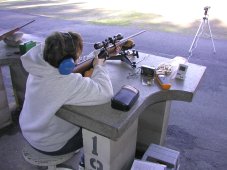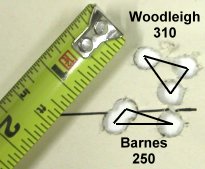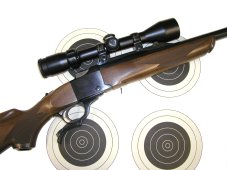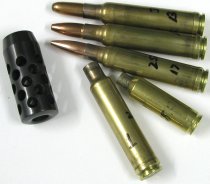
Even in California it can get a little cool. My wife packed on a lot of clothing to feel comfortable at 38°F and 84% humidity. You can’t see in this picture (taken from the car, with the heater running), but that’s what it indicates on that little white bench thermometer. It was an excellent range day, we had the range almost entirely to ourselves so we ran through the work part pretty quickly, and had a chance to shoot just for fun. The past couple of months I’ve been reaching past the Ruger No.1 .358-378RG to the guns that were the subject of then active articles, but I kept thinking I needed to take some time and bring the Ruger and some handloads up to the range.
A funny thing happens when I haven’t shot a rifle for some time, I forget it’s personality. So I pulled the trigger on a light 200 grain Hornady load, the brake ate most of the recoil, noise was moderate and the bullet went pretty much where I anticipated. Easy enough, so I plopped in a full up 310 grain Woodleigh load, leaned a bit too far forward, let the forearm float on the rest and squeezed the trigger. The muzzle rose, significantly, at least too much for me to pretend I expected that result. A pressure wave hit me in the face, unblocked my sinuses and left me with a dull yet memorable headache, and that skinny petrified Ruger recoil pad imprinted the Ruger logo on my shoulder. Neat! Three guys nearby immediately asked if they could take a shot – gun people.
 I frequently get email from people asking if I know of ways to get accuracy and consistent shot placement out of the Ruger No.1. I don’t think there is a general belief that I have unique knowledge in this area, as much as the .358-378 RG project appears on the site in a number of places and suggests some level of hands on experience with the firearm. My Ruger shoots pretty well. Today it was shooting 3/4″ groups with just about everything I could stuff into it; no stringing, no flyers and no surprises. I used no special wrestling hold to keep the gun steady on the rest, I take no extra care to avoid interfering with the gun’s natural vibrations, “vibes” to those west of Arizona, and I have attached no gadgets to alter the gun’s mechanical design.
I frequently get email from people asking if I know of ways to get accuracy and consistent shot placement out of the Ruger No.1. I don’t think there is a general belief that I have unique knowledge in this area, as much as the .358-378 RG project appears on the site in a number of places and suggests some level of hands on experience with the firearm. My Ruger shoots pretty well. Today it was shooting 3/4″ groups with just about everything I could stuff into it; no stringing, no flyers and no surprises. I used no special wrestling hold to keep the gun steady on the rest, I take no extra care to avoid interfering with the gun’s natural vibrations, “vibes” to those west of Arizona, and I have attached no gadgets to alter the gun’s mechanical design.
 The primary reason the Ruger shoots so well, and looks so good is Dennis Olson of Plains, Montana, or at least Dennis and the Lilja barrel he installed. From an appearance standpoint, I think the rifle could get lost in a rack of other Ruger Tropical No. 1 rifles. With the exception of a 26″ barrel and a removable brake, everything else is intact as a factory model. All of the hardware, sights and barrel band, were transferred to the new barrel, and the bluing matches and carries through as nicely finished factory pieces. The plain Jane walnut stock is still intact, thanks to the barrel being accurately turned to a factory duplicate profile. For this outing, the gun was wearing a really cheap scope that ran out of adjustment range while bore sighting.
The primary reason the Ruger shoots so well, and looks so good is Dennis Olson of Plains, Montana, or at least Dennis and the Lilja barrel he installed. From an appearance standpoint, I think the rifle could get lost in a rack of other Ruger Tropical No. 1 rifles. With the exception of a 26″ barrel and a removable brake, everything else is intact as a factory model. All of the hardware, sights and barrel band, were transferred to the new barrel, and the bluing matches and carries through as nicely finished factory pieces. The plain Jane walnut stock is still intact, thanks to the barrel being accurately turned to a factory duplicate profile. For this outing, the gun was wearing a really cheap scope that ran out of adjustment range while bore sighting.

I’ve had very good success with Weatherby cartridges, particularly those based on the large diameter .378 Weatherby case. Maybe more of the WSM philosophy in a stretched form. Even my .416 Weatherby is a tack driver and relatively easy to shoot with a stock more properly designed to manage the forces of recoil. At 100 ft/lbs of recoil, the .416 has almost 70 ft/lbs more, but you’d never know it by shooting them. Consequently, at the range the Ruger wears a brake at all time which, jokes aside, makes it easy to shoot.
The small cartridge case mixed in to the right, suggests why Winchester labeled their newest magnums “short”. The .358-378 RG, a necked down .378 Weatherby, has a case capacity of just a tad under 140 grains. The Ruger accurately handles bullet weights from 200 to 310 grains, at velocity very close to the .378 Weatherby with bullets of greater sectional density. The gun could probably kill something relatively large, but it never will, because I won’t hunt big game with a single shot rifle. In any case, neither hunting potential, or jumbo cartridge are the reason I like this gun.
As rifles go, particularly custom pieces with quality parts, this one was a cheap date. The new Ruger No. 1 Tropical rifle, a custom chamber reamer for the .358-378, custom reloading dies, the Lilja barrel, and Dennis Olson’s meticulous assembly resulted in a nicely finished gun that came in at just over $1,600. The .358-378RG isn’t a break through wildcat, but it was the result of a lot of trial and error and sifting through lots of cartridges for the proper bore, capacity and performance goals. It was fun generating cartridge drawings and reamer specs, it was pretty neat getting loading dies fromCH4D with 358-378RG stamped on them. Picking a barrel maker led to a lot of research and new information regarding bullet stability and the underlying factors of accuracy. Finally, it was a pleasure to interact, if even in a very small way, with someone as skilled and straight forward as Dennis. The best part? Squeezing the trigger on that first handload. Here’s a handload performance overview from today.
I’m looking forward to the coming year, and perhaps a chance to take this process a step further. In the mean time Happy Holidays and the Best for the New Year. And for you folks who still believe in Santa, a very Merry Christmas.
Thanks
Joe

Email Notification